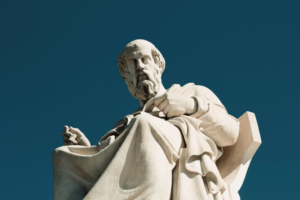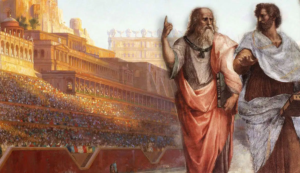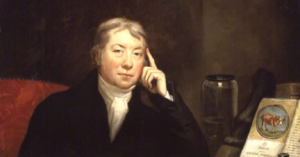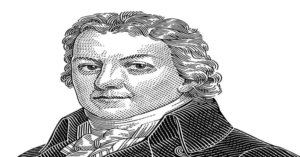Plato’s philosopher-king vs democratic leadership
The Leader We’re Starving For (But Would Never Elect)

Why Plato 2,400-Year-Old Pipe Dream Still Stabs Us in the Chest
You feel it in line at the grocery store.
Watching the price of bread climb while a CEO brags about “record profits.”
You feel it at the town hall meeting.
Where the developer’s lawyer whispers to the mayor who won’t meet your eyes.
You feel it when the news cuts away from flood victims to a polished liar smirking at a podium.
That hollow ache behind your ribs?
Plato named it.
His story starts with betrayal.
Not a philosophical disagreement – a murder.
His mentor, Socrates – the original “guy who asked too many questions” – was sentenced to death. By Athens. By a democracy. The charges? “Corrupting the youth” (translation: teaching them to think) and “impiety” (translation: questioning the powerful).
They made him drink poison.
For telling truths that stung.
This wasn’t academic.
It was trauma.
The system murdered Plato’s moral compass.
It broke something fundamental in him.
(It’s breaking something in you right now, isn’t it?)
The Ugly Truth He Couldn’t Unsee
Plato surveyed the wreckage of his world:
- “Democracy”: Just mob rule jacked up on sweet-talkers and fear-mongers. Think viral misinformation, but with togas. The crowd cheered for wars they didn’t understand and turned on heroes overnight.
- Oligarchs: Spoiled rich kids playing Game of Thrones with real lives. Using laws like lockpicks on the public treasury. Sound familiar?
- Tyrants: Bullies with absolute power and the empathy of a brick. Rising to power on waves of manufactured rage.
His diagnosis wasn’t complicated. It was devastating:
“The rot isn’t in the rules. It’s in the souls making them. Feed a broken soul absolute power? You get hell. Until rulers have wisdom and actual character, we’re all just rearranging deck chairs on the Titanic.”
His proposed cure was radical, almost laughable in its purity:
Find the wisest, kindest, most brutally honest person you know… and force them to be in charge.
Call them the Philosopher-King.
(History’s awkward cough: It’s never happened. Not once. Not for long.)
Forget the Toga Party (Seriously, They Didn’t Even Wear Them Like That)

This isn’t about some marble statue muttering about clouds. Plato’s ideal leader is shockingly, uncomfortably human:
| The Leaders We Get | The Leader Plato Wanted | Why It Feels Like a Kick in the Teeth |
|---|---|---|
| 🐺 Power Junkies | 🚫 Power Allergics | Our system rewards narcissists who campaign like it’s their destiny |
| 🎭 Charisma Salesmen | 🔍 Truth Addicts | Ours spin reality; theirs would rather die than distort it |
| 📊 Data Bots | ❤️ Soul Gardeners | They see policies as people drowning, not statistics to manipulate |
| 💰 Perk Collectors | ✂️ Privilege Surgeons | Ours exploit loopholes; theirs would burn the system that allows them |
| 🎯 Short-Term Grifters | 🌳 Generational Caretakers | Ours mortgage our future; theirs plant trees whose shade they’ll never sit under |
3 Brutal Realities of a Real Philosopher-King
1. They’d Genuinely Rather Be Scrubbing Toilets
Imagine forcing a brilliant cancer researcher to quit the lab to become a DMV clerk. That’s the agony of a true Philosopher-King taking power. Ruling isn’t their dream – it’s a moral life sentence. Their superpower? They find zero joy in dominance.
→ Why it cuts so deep: We watch candidates spend billions lusting after a job a decent person would dread. That’s not ambition. That’s pathology.
2. Plato: They’ve Seen Behind the Curtain
Plato’s Cave is now: We mistake curated shadows (TikTok trends, news spin, political theater) for reality. The Philosopher-King? They’ve stumbled into the blinding, terrifying light of actual truth. They’ve seen the gears of greed, the wiring of hate, the machinery of exploitation – and they can’t unsee it. Every policy, every word, bleeds from that unvarnished, painful clarity.
→ Why we look away: Our leaders profit from keeping us chained in the cave. Asking us to face reality? That’s bad for business.
3. They’ve Washed the Blood Off Their Hands
Before they’re allowed near ultimate power? 15 years in the human trenches:
- Mediating screaming matches between families feuding over a stolen chicken 🐔
- Kneeling in the mud holding a teenager bleeding out from a stupid street fight 🔪
- Getting spat on by a crowd for closing a beloved but toxic factory poisoning their kids ☣️
There is no theory of justice that survives first contact with a mother wailing over her child’s body.
→ Why we’re cynical: Our elites glide from gated communities to green rooms, insulated from the consequences of their decisions.
Plato: Why This Ancient Idea BURNS in 2024
We’ve stopped believing good leaders are even possible.
Our collective surrender smells like:
- Memeing politics like a dystopian sitcom instead of storming barricades 🤡
- Saying “they’re all corrupt” while checking the box for the less corruptible liar ✔️
- Treating voter suppression and gerrymandering like “politics as usual” instead of the democracy-killing cancers they are 🧬
But when the roof caves in – when hospitals overflow, when cities burn, when the water rises – we scream into the void for EXACTLY what Plato described:
- A leader who cares more about your dying grandmother than their fucking approval rating
- Someone whose moral compass doesn’t have a “spin cycle” setting
- A servant who sees power as a crushing responsibility, not a golden ticket
Plato Where the Dream Flickers
Look closer than the headlines. The DNA survives in the cracks:
The Ragged Saints:
- The overworked public defender who knows her client is guilty but fights to expose the crooked cop who framed him anyway.
- The retired steelworker spending his pension busing neighbors to the polls in a county trying to silence them.
- The small-town librarian facing down armed protesters because some kid needs to see their face in a book and feel less alone.
How You Spot the Spark:
- ✅ They flinch at praise (Unlike our preening leaders)
- ✅ They talk about “we,” never “I” (Unlike our raging narcissists)
- ✅ Their eyes hold tired grief, not ambition’s gleam (The look of someone who sees the cost)
They aren’t Philosopher-Kings.
They’re underpaid, overmatched, and scared shitless.
But they carry the sacred rage:
Refusing to let the light go out.
The Uncomfortable Truth Plato Forces Down Our Throats
We don’t need perfect leaders.
We’ve just weaponized our apathy.
Plato’s real power isn’t some dusty blueprint.
It’s the cracked mirror he slams in front of us:
“You share the outrage porn clip but skip the town hall meeting.
You complain about ‘politicians’ while taking the dark money PAC’s campaign mailer straight to the recycling bin.
You say ‘my vote doesn’t matter’ in a system designed to make you believe it.
You are complicit in your own chains.”
His Philosopher-King isn’t a solution.
It’s an indictment.
A scream trapped in history’s throat:
“When did you trade your hope for this numb, compliant despair?”
Plato The Ghost You Can’t Exorcise
We’ll never get Plato’s perfect leader.
Corruption’s gravity is too strong.
Human nature’s too flawed.
The system’s too rigged.
But that raw, screaming hunger in your chest?
That refusal to accept that grifters and fools deserve to rule us?
That midnight fury when you watch another lie go un



